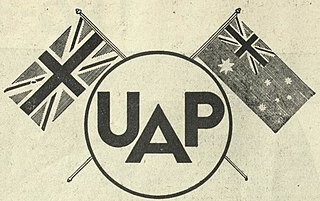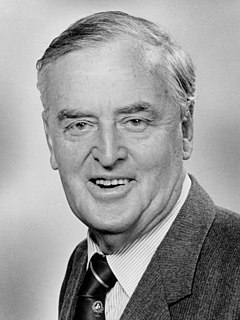
The Liberal Party of Australia is a centre-right political party in Australia, one of the two major parties in Australian politics, along with the centre-left Australian Labor Party. It was founded in 1944 as the successor to the United Australia Party.
The National Party of Australia (NPA), also known as The Nationals or The Nats, is an Australian political party. Traditionally representing graziers, farmers, and regional voters generally, it began as the Australian Country Party (ACP) in 1920 at a federal level. It later adopted the name National Country Party in 1975, before taking its current name in 1982.

The United Australia Party (UAP) was an Australian political party that was founded in 1931 and dissolved in 1945. The party won four federal elections in that time, usually governing in coalition with the Country Party. It provided two Prime Ministers of Australia – Joseph Lyons (1932–1939) and Robert Menzies (1939–1941).

Sir Arthur William Fadden, was an Australian politician who served as the 13th Prime Minister of Australia from 29 August to 7 October 1941. He was the leader of the Country Party from 1940 to 1958.

The Liberal–National Coalition, commonly known simply as "the Coalition", is an alliance of centre-right political parties that forms one of the two major groupings in Australian federal politics. The two partners in the Coalition are the Liberal Party of Australia and the National Party of Australia. Its main opponent is the Australian Labor Party (ALP); the two forces are often regarded as operating in a two-party system. The Coalition was last in government from the 2013 federal election, before being unsuccessful at re-election in the 2022 Australian federal election. The group was led by Scott Morrison until the 2022 Australian federal election, where he resigned as leader. His successor is Peter Dutton.

Arthur Edward Moore was an Australian politician. He was the Country and Progressive National Party Premier of Queensland, from 1929 to 1932. He was the only Queensland Premier not to come from the ranks of the Labor Party between 1915 and 1957. Although successful in achieving the unity of the conservative forces in Queensland for an extended period, Moore's abilities were tested by the onset of the Great Depression and like many other governments in Australia and elsewhere his was unable to endure the formidable challenges it posed.

The Liberal National Party of Queensland (LNP) is a major political party in Queensland, Australia. It was formed in 2008 by a merger of the Queensland divisions of the Liberal Party and the National Party. At a federal level and in most other states, the two parties remain distinct and operate as a Coalition. The LNP is a division of the Liberal Party of Australia, and an affiliate of the National Party of Australia.

Angaston is a town on the eastern side of the Barossa Valley in South Australia, 77 km northeast of Adelaide. Its elevation is 347 m, one of the highest points in the valley, and has an average rainfall of 561 mm. Angaston was originally known as German Pass, but was later renamed after the politician, banker and pastoralist George Fife Angas, who settled in the area in the 1850s. Angaston is in the Barossa Council local government area, the state electoral district of Schubert and the federal Division of Barker.

Elections were held in the Australian state of Queensland on 22 October 1983 to elect the 82 members of the state's Legislative Assembly.
The Queensland Labor Party (QLP) was a political party of Queensland, Australia formed in 1957 by a breakaway group of the then ruling Labor Party Government after the expulsion of Premier Vince Gair. In 1962 the party became the Queensland section of the Democratic Labor Party (DLP). The party continued to hold seats in the Queensland state parliament until 1972, then suffered a collapse in its vote and wound itself up in 1978.

Thomas Bridson Cribb was a politician in Queensland, Australia. He was a Member of the Queensland Legislative Assembly and the Queensland Legislative Council.

The National Party of Australia – Victoria is a political party in Victoria, which forms the state branch of the federal Nationals. Traditionally representing graziers, farmers and rural voters generally. The Victorian Farmer's Union formed in 1914 was the precursor to the Victorian Country Party, later the Nationals.
Ross Francis Gollan was an Australian journalist who was known for his work as a political reporter for The Sydney Morning Herald. He worked for the paper from 1923 until his death, and was a member of the Canberra Press Gallery from 1940 to 1946.

Herbert Robinson Brookes was an Australian businessman, philanthropist, and political activist. He inherited substantial holdings from his father, and served as president of the Victorian Chamber of Manufactures. He was involved in numerous charities, and was a major benefactor to the University of Melbourne, his alma mater. Brookes also filled various governmental positions, serving on the Board of Trade, the Tariff Board, the Australian Broadcasting Commission, and briefly as the first Commissioner-General to the United States.
The National Party of Australia – Queensland, commonly known as The Nationals Queensland, was the Queensland state branch of the National Party of Australia until 2008. Prior to 1974, it was known as the Country Party.
The Country-National Organisation was a short-lived conservative political party in the Australian state of Queensland during the Second World War.

The Liberal Party of Australia , branded as Liberal Queensland, was the Queensland division of the Liberal Party of Australia until 2008.
The United Australia Party was the short-lived Queensland branch of the national United Australia Party in the 1930s and 1940s. Based around Brisbane, it spent the entire of its history in opposition, merging in 1941 into the Country-National Organisation. When that party separated in 1944, the remnants of the UAP joined the Queensland People's Party which in 1949 became the Liberal Party of Australia
The National Party, later the United Party was a political party in the Australian state of Queensland from 1917 until 1925. Although allied with the federal Nationalist Party, it had different origins in state politics. It sought to combine the state's Liberal Party with the Country Party but the latter soon withdrew. In 1923 the party sought a further unification with the Country Party but only attracted a few recruits. Then in 1925 it merged with the Country Party, initially as the Country Progressive Party with a few members left out and then they were absorbed into the renamed Country and Progressive National Party.
The Liberal Party was a political party in the Australian state of Queensland in the early 20th century. It combined the main non-Labor forces, the "Kidstonites" of William Kidston and the Conservatives of Robert Philp, similar to the federal Commonwealth Liberal Party whose fusion it preceded. The Liberals held government from their formation in 1908 until defeat in 1915 after which they combined with other elements in the state to form the National Party.











